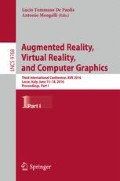Abstract
This article comprises a study on user experience when interacting with different modes of mobile interfaces. Our emphasis is on application instances commonly found in mobile app stores, which utilize sensor-based augmented reality or two-dimensional zoomable maps to visualize points of interest (POIs) in the vicinity of the user. As a case study, we developed two variants of an Android application addressed to public transportation users. The application displays nearby transit stops along with timetable information of transit services passing-by those stops. We report findings drawn from an empirical field study in real outdoors conditions. The evaluation findings have been cross-checked with logged (usage) data. We aim at eliciting knowledge about user requirements related to mobile application interfaces in this context and evaluating user experience from pragmatic and affective viewpoints.
Access this chapter
Tax calculation will be finalised at checkout
Purchases are for personal use only
Notes
- 1.
- 2.
- 3.
- 4.
For instance, the GTFS feeds for the metropolitan transport networks of Athens and Paris are 151 MB and 721 MB, respectively. The database storing the Athens GTFS data occupies 278 ΜΒ (due to the redundancy introduced by indices used to speedup information search).
References
Carmigniani, J., Furht, B., Anisetti, M., Ceravolo, P., Damiani, E., Ivkovic, M.: Augmented reality technologies, systems and applications. Multimedia Tools Appl. 51(1), 341–377 (2011)
Jacobson, R.D.: Navigating maps with little or no sight: an audio-tactile approach. In: Proceedings of the Workshop on Content Visualization and Intermedia Representations (1998)
Nurminen, A., Järvi, J., Lehtonen, M.: A mixed reality interface for real time tracked public transportation. In: Proceedings of the 10th ITS European Congress (2014)
Olsson, T., Kärkkäinen, T., Lagerstam, E., Ventä-Olkkonen, L.: User evaluation of mobile augmented reality scenarios. J. Ambient Intell. Smart Environ. 4(1), 29–47 (2012)
Pielot, M., Boll, S.: Tactile wayfinder: comparison of tactile waypoint navigation with commercial pedestrian navigation systems. In: Floréen, P., Krüger, A., Spasojevic, M. (eds.) Pervasive 2010. LNCS, vol. 6030, pp. 76–93. Springer, Heidelberg (2010)
Rehrl, K., Häusler, E., Leitinger, S., Bell, D.: Pedestrian navigation with augmented reality, voice and digital map: final results from an in situ field study assessing performance and user experience. J. Location Based Serv. 8(2), 75–96 (2014)
Sarjakoski, L.T., Nivala, A.M.: Adaptation to context-a way to improve the usability of mobile maps. In: Meng, L., Reichenbacher, T., Zipf, A. (eds.) Map-Based Mobile Services, pp. 107–123. Springer, Heidelberg (2005)
Setlur, V., Kuo, C., Mikelsons, P.: Towards designing better map interfaces for the mobile: experiences from example. In: Proceedings of the 1st International Conference and Exhibition on Computing for Geospatial Research & Application (2010)
Wen, J., Helton, W.S., Billinghurst, M.: A study of user perception, interface performance, and actual usage of mobile pedestrian navigation aides. Proc. Hum. Factors Ergon. Soc. Annu. Meet. 57(1), 1958–1962 (2013)
Yovcheva, Z., Buhalis, D., Gatzidis, C.: Smartphone augmented reality applications for tourism. e-Review Tourism Res. (eRTR) 10(2), 63–66 (2012)
Acknowledgement
This work has been supported by the CIP-ICT-PSP-2013-2017 Programme under grant agreement no. 621133 (HoPE - “Holistic Personal public Eco-mobility”).
Author information
Authors and Affiliations
Corresponding author
Editor information
Editors and Affiliations
Rights and permissions
Copyright information
© 2016 Springer International Publishing Switzerland
About this paper
Cite this paper
Kamilakis, M., Gavalas, D., Zaroliagis, C. (2016). Mobile User Experience in Augmented Reality vs. Maps Interfaces: A Case Study in Public Transportation. In: De Paolis, L., Mongelli, A. (eds) Augmented Reality, Virtual Reality, and Computer Graphics. AVR 2016. Lecture Notes in Computer Science(), vol 9768. Springer, Cham. https://doi.org/10.1007/978-3-319-40621-3_27
Download citation
DOI: https://doi.org/10.1007/978-3-319-40621-3_27
Published:
Publisher Name: Springer, Cham
Print ISBN: 978-3-319-40620-6
Online ISBN: 978-3-319-40621-3
eBook Packages: Computer ScienceComputer Science (R0)

